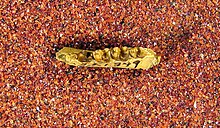Microsyopidae
Görünüm
| Mikrosyopidler | |||||||||||||
|---|---|---|---|---|---|---|---|---|---|---|---|---|---|
 Microsyops cardiorestes'in çenesi | |||||||||||||
| Biyolojik sınıflandırma | |||||||||||||
| |||||||||||||
| Alt gruplar | |||||||||||||
| Metne bakınız. | |||||||||||||
Microsyopidler (Microsyopidae), Kuzey Amerika ve Avrupa'nın Paleosen ve Eosen dönemlerinden bilinen bir plesiadapiform familyası.[2]
Taksonomi
[değiştir | kaynağı değiştir]- Microsyopidae ailesi Osborn & Wortman, 1892
- Toliapininae at familyası
- Cins Altiatlasius? Sige, Jaeger, Sudre & Vianey-Liaud, 1990
- Altiatlasius koulchii Sige, Jaeger, Sudre & Vianey-Liaud, 1990
- Cins Avenius Russell, Phélizon ve Louis, 1992
- Avenius amatör Russel, Phélizon ve Louis, 1992
- Cins Berruvius Russell, 1964
- Berruvius lasseroni Russell, 1964
- Cins Sarnacius Hooker, Phélizon & Russell, 1999
- Sarnacius gingerichi (Russell, 1981)
- Cins Seia Russell & Gingerich, 1981
- Seia shahi (Gingerich, 1981)
- Cins Toliapina[3] Hooker & Phélizon & Russell, 1999
- Toliapina lawsoni Hooker & Phélizon & Russell, 1999
- Toliapina vinealis Hooker & Phélizon & Russell, 1999 (tür türleri )
- Cins Altiatlasius? Sige, Jaeger, Sudre & Vianey-Liaud, 1990
- Uintasoricinae Szalay alt familyası, 1969
- Navajoviini Kabilesi Szalay & Delson, 1979
- Cins Choctawius[4] Beard & Dawson, 2009
- Choctawius foxi Sakal ve Dawson, 2009
- Choctawius mckennai (Szalay, 1969)
- Cins Navajovius Granger & Matthew, 1921
- Navajovius kohlhaasae Granger ve Matta, 1921
- Cins Choctawius[4] Beard & Dawson, 2009
- Uintasoricini oymağı
- Cins Bartelsia[5] Gunnell, 2012
- Bartelsia pentadactyla Gunnell, 2012
- Cins Nanomomys[6] Rose ve ark., 2012
- Nanomomys thermophilus Rose ve ark., 2012
- Cins Niptomomys McKenna, 1960
- Niptomomys doreenae McKenna, 1960
- Niptomomys favorum Boğazı, 2001
- Niptomomys thelmae Gunnell & Gingerich, 1981
- Cins Uintasorex (Matta, 1909)
- Uintasorex montezumicus Lillegraven, 1976
- Uintasorex parvulus (Matta, 1909)
- Cins Bartelsia[5] Gunnell, 2012
- Navajoviini Kabilesi Szalay & Delson, 1979
- Mikrosyopinae Alt Ailesi Osborn & Wortman, 1892
- Cins Arctodontomys Gunnell, 1985
- Arctodontomys nuptus (Cope, 1882)
- Arctodontomys simplicidens (Rose, 1981)
- Arctodontomys wilsoni (Szalay, 1969)
- Cins Craseops Stoku, 1932
- Craseops sylvestris Stoku, 1932
- Cins Megadelphus Gunnell, 1989
- Megadelphus lundeliusi (Beyaz, 1952)
- Cins Microsyops Leidy, 1872
- Microsyops angustidens Matta, 1915
- Microsyops annectens (Marsh, 1872)
- Microsyops elegans (Marsh, 1871) (tür türleri)
- Microsyops knightensis Gazin, 1952
- Microsyops kratos Stoku, 1938
- Microsyops latidens Cope, 1882
- mikrosiops lundeliusi
- Microsyops scottianus (Kope, 1881)
- Cins Arctodontomys Gunnell, 1985
- Toliapininae at familyası
Altiatlasius cinsi, Euprimates'in bir bazal soyuna ait olabilir.[2] Alveojunctus Bown, 1982 cinsi Uintasoricini oymağına ait olabilir[3] veya Picromomyx ile birlikte Microsyopidae içinde Picromomyinae alt ailesini oluşturur.[5]
Kaynakça
[değiştir | kaynağı değiştir]- ^ "PBDB". paleobiodb.org. 10 Ağustos 2021 tarihinde kaynağından arşivlendi. Erişim tarihi: 10 Ağustos 2021.
- ^ a b Bloch JI, Silcox MT, Boyer DM, Sargis EJ (2007) New Paleocene skeletons and the relationship of ‘‘plesiadapiforms’’ to crown-clade primates. Proc Natl Acad Sci 104:1159–1164.
- ^ a b J. J. Hooker, D. E. Russell, and A. Phélizon. 1999. A new family of plesiadapiformes (Mammalia) from the old world lower Paleogene. 5 Mart 2016 tarihinde Wayback Machine sitesinde arşivlendi. Palaeontology 42(3):377-407.
- ^ K. C. Beard and M. R. Dawson. 2009. Early Wasatchian mammals of the Red Hot local fauna, uppermost Tuscahoma Formation, Lauderdale County, Mississippi. Annals of Carnegie Museum 78(3):193-243.
- ^ a b Gregg F. Gunnell (2012). "New Uintasoricine (?Primates, Plesiadapiformes) from the Earliest Bridgerian, Latest Early Eocene of Wyoming". Journal of Paleontology. 86 (6): 973-978. doi:10.1666/12-022R.1.
- ^ Rose, K. D., A. E. Chew, R. H. Dunn, M. J. Kraus, H. C. Fricke, AND S. P. Zack. 2012. Earliest Eocene mammalian fauna from the Paleocene–Eocene Thermal Maximum at Sand Creek Divide, southern Bighorn Basin, Wyoming. University of Michigan Papers on Paleontology, 36:1–122.
| Plesiadapiform ile ilgili bu madde taslak seviyesindedir. Madde içeriğini genişleterek Vikipedi'ye katkı sağlayabilirsiniz. |
